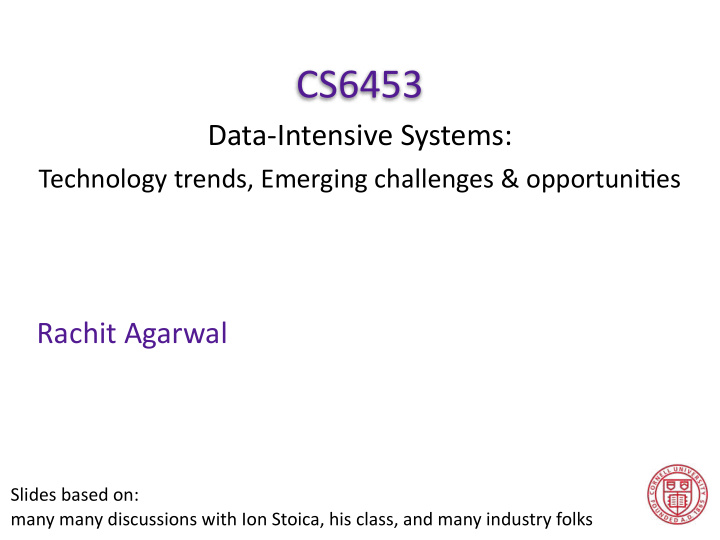



CS6453 Data-Intensive Systems: Technology trends, Emerging challenges & opportuni=es Rachit Agarwal Slides based on: many many discussions with Ion Stoica, his class, and many industry folks
Servers — Typical node Memory bus PCI Ethernet SATA
Servers — Typical node Time to Capacity read 80GB/s Memory bus 100s GB 10s sec
Servers — Typical node Time to Capacity read 80GB/s Memory bus 100s GB 10s sec PCI (1GB/s) 100s GB 10s min
Servers — Typical node Time to Capacity read 80GB/s Memory bus 100s GB 10s sec PCI (1GB/s) 100s GB 10s min 10s min 600MB/s SATA 100MB/s 1s TB hours
Trends — Moore’s law slowing down? • Stated 50 years ago by Gordon Moore • Number of transistors on microchip double ~2 years • Why interesting for systems people? • Bryan Krzanich — Today, closer to 2.5 years
Trends — CPU (#cores) Today, +20% every year
Servers — Trends +20% Memory bus PCI Ethernet SATA
Trends — CPU (performance per core) Today, +10% every year
Trends — CPU scaling • Number of cores: +20% • Performance per core: +10% • Overall: +30-32%
Servers — Trends +30% Memory bus PCI Ethernet SATA
Trends — Memory +29% every year
Servers — Trends +30% +30% Memory bus PCI Ethernet SATA
Trends — Memory Bus +15% every year
Servers — Trends +15% +30% +30% Memory bus PCI Ethernet SATA
Trends — SSD SSDs cheaper than HDD
Trends — SSD capacity scaling • Following Moore’s law (late start) • 3D technologies • May even outpace Moore’s law
Servers — Trends +15% +30% +30% Memory bus PCI + >30% Ethernet SATA
Trends — PCI bandwidth (and ~SATA) +15-20% every year
Servers — Trends +15% +30% +30% Memory bus PCI + >30% +15-20% Ethernet SATA
Trends — Ethernet bandwidth +33-40% every year
Servers — Trends +15% +30% +30% Memory bus PCI + >30% +15-20% Ethernet +40% SATA
Trends — Implications? • Intra-server Bandwidth an increasing bottleneck • How could we overcome this? • Reduce the size of the data? • What does that mean for applications? • Prefer remote over local? • Challenges? • Non-intuitive; we always prefer locality
Trends — Emergence of new technologies • Non-volatile memory • 8-10x density of DRAM (close to SSD) • 2-4x higher latency • But who cares? Bandwidth is the bottleneck…
Trends — Emergence of new technologies
Trends — Emergence of new technologies heps://www.youtube.com/watch?v=IWsjbqbkqh8
Trends — & Implications • HDD is new tape • SSD/NVRAM is the new persistent storage • But, increasing gap between capacity and b/w concerning … • Deeper storage hierarchy (L1, L2, L3, DRAM, NVRAM, SSD, HDD) • Do CPU caches even matter? • How do design software stack to work with deeper hierarchy? • CPU-storage “disaggregation” is going to be a norm • Easier to overcome bandwidth bottlenecks • Google and Microsoft have already realized • What happens to locality? • Re-think software design?
Paper 1 — Memory-centric design • SSD/NVRAM is the new persistent storage (+archival) • Not just the persistent storage, THE storage • +(private memory), deep storage hierarchy • CPU-storage “disaggregation” • NVRAM shared across CPUs • Challenges? • How to manage/share resources? • NVM: accelerators and controllers • Addressing? Flat virtual address space? • NVM sharing in multi-tenant scenarios? • NVM+CPU+Network: software-controlled? • Storage vs compute heavy workloads?
Paper 1 — Memory-centric design • New failure modes? [very interesting direction!!] • CPU-storage can fail independently • Very different from today’s “servers” • Good? Bad? • Transparent failure mitigation…? • How about the OS? • Where should the OS sit? • What functionalities should be implemented within the OS? • Application-level semantics • ?
Paper 2 — Nanostores (An alternative view) • DRAM is dead • SSD/NVRAM is the new persistent storage (+archival) • Not just the persistent storage, THE storage • No storage hierarchy • CPU-storage “convergence” is going to be a norm • CPU-storage hyper-convergence • Berkeley IRAM project (late 90s) • Challenges? • Network? (topology, intra-nanostore latency, throughput) • How does this bypass the trends discussed earlier?
Trends — The missing piece? • Data volume increasing significantly faster than Moore’s law • 56x increase in Google indexed data in 7 years • 173% increase in enterprise data • Uber, Airbnb, Orbitz, Hotels, … • Data types • Images, audio, videos, logs, logs, logs, genetics, astronomy, …. • YouTube: ~50TB of data every day
Trends — Discussion • Other missing pieces? • Software overheads • Application workloads • Specialization vs. generalization?
Recommend
More recommend